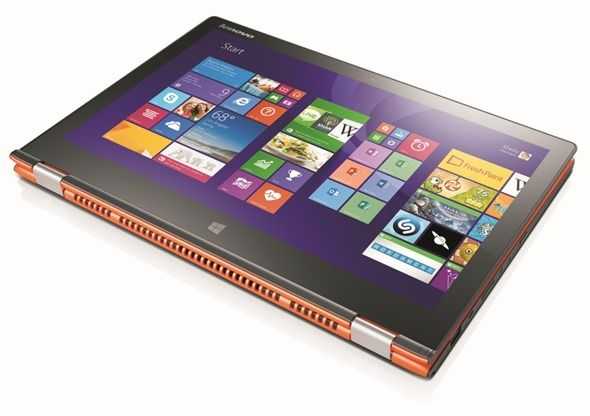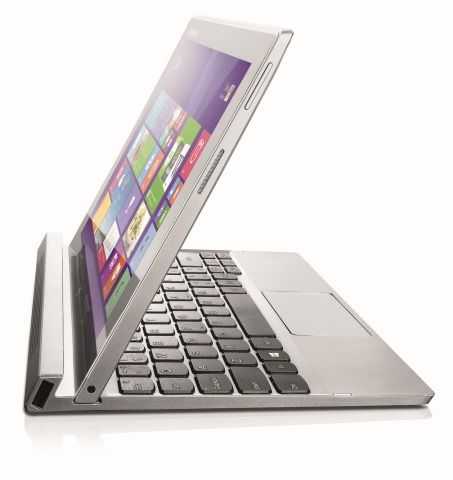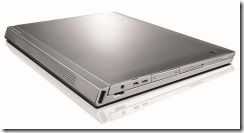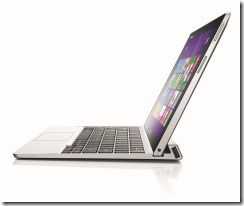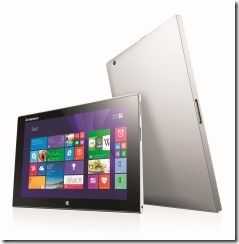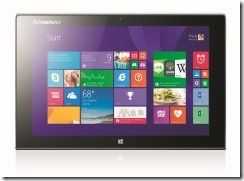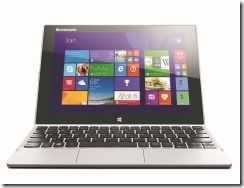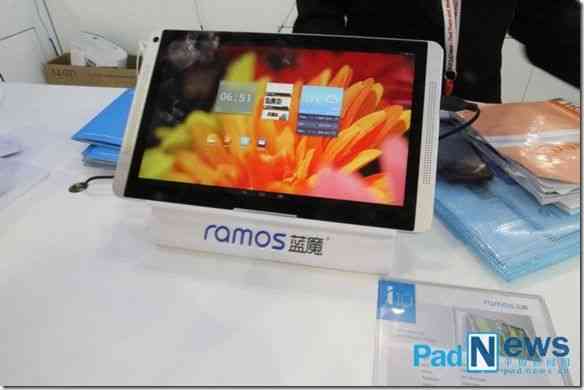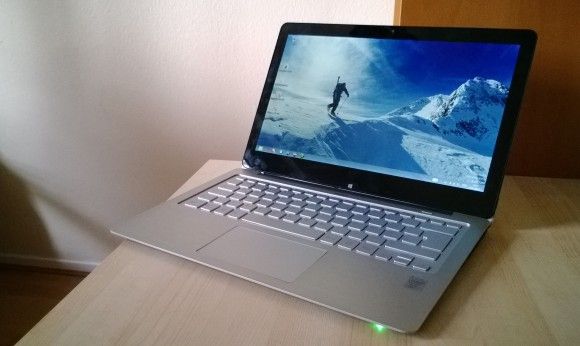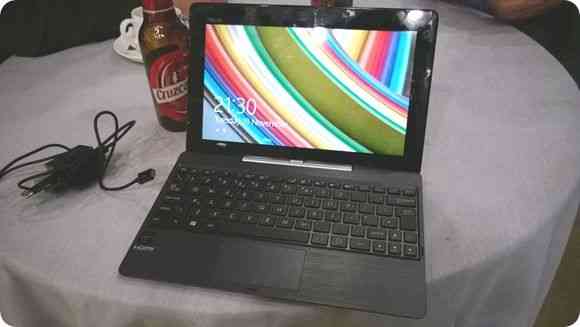As we expected, the new Yoga 2 11S is going to be one for the masses. It’s been spotted for $499. The Pentium N3510 doesn’t have some of the features of the Core processors and there’s a spinning hard drive but in this market, maybe that’s not important. The Lenovo Yoga 2 11 could be a great mass-market subnotebook.
Tag Archive | "convertible"
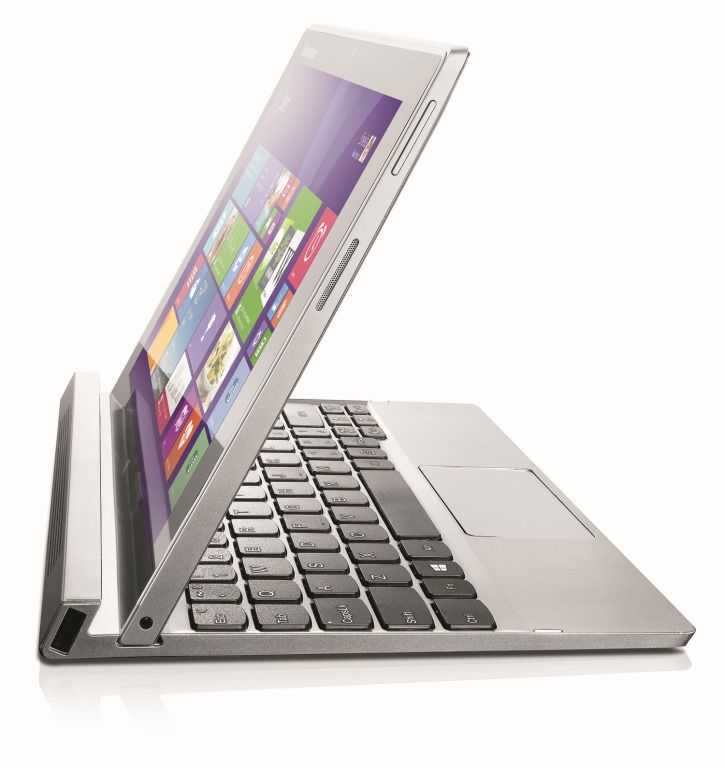
Lenovo Miix2 10 Launched. 3 Modes in 2.3 Pounds
Posted on 06 January 2014
Tablet, Laptop , Easel. The Lenovo Miix 2 10 is based on Baytrail, weighs 1.3 pounds (tablet-only) and looks like it will kill the market for the Acer W510 stone dead. Let’s hope the keyboard is better than the one on the Lenovo Lynx! The 10-inch MIIX 2 starts at $499 and will be available in March.
From the press release:
The Lenovo MIIX 2 is ideal for those who frequently use both a tablet and a laptop. The Windows 8.1 tablet can be attached to a keyboard dock, instantly turning into a full-performing laptop perfect for entertainment and productivity while on the go. Available in ultra-portable 10.1-in and performance-focused 11.6-in models, MIIX 2 gives users the ability to easily switch between three modes – Tablet, Laptop, Stand – for specific computing needs.
Obviously the 11-inch model is more Ultrabook-focused so we’ll be covering that over at our sister site. Fingers crossed that it has the Z3770 with max 2.4Ghz clock.
Specifications:
- Processor: Quad Core Intel® Atom® processor
- Operating System Genuine Windows 8.1
- Display/Resolution 10.1” full HD display (1920×1200) with 10-point touch and 178o wide viewing angle
- Video Graphics Integrated Intel HD graphics
- Memory 2GB LP-DDR3 memory
- Storage Up to 128GB integrated eMMC storage, up to 32GB add-on micro SD card support
- Sound Integrated JBL® designed stereo speakers (on tablet) and subwoofer (on keyboard-dock)
- Integrated Comms 1 mini HDMI port, 1 micro USB port, 1 integrated USB 2.0 connector (on keyboard-dock)
- Keyboard Detachable AccuType keyboard
- Connectivity Integrated Bluetooth 4.0, 802.11 a/b/g/n Wi-Fi and optional 3G-GPS connectivity
- Camera 720p high resolution 2MP front and 5MP rear cameras
- Battery Up to 8 hours of battery life
- Weight: Tablet: 1.3 pounds, Keyboard Dock: 0.97 pounds
- Dimensions 10-in: Pad: 260.9 x 173.2 x 9.2mm, Dock: 260.9 x 183.4 x 7.0mm

Lenovo Yoga 11S (Core i3, $699 version) Video Review
Posted on 11 December 2013
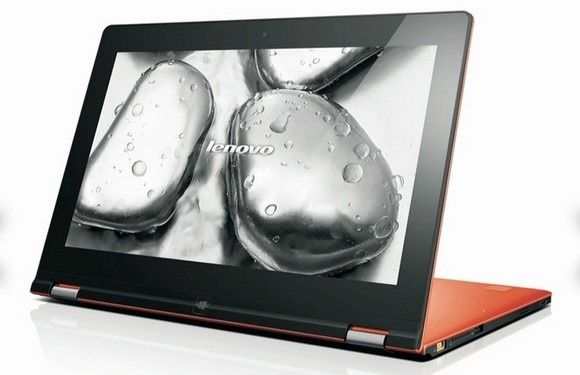
For those that are interested in the Lenovo Yoga 11S (and I’m sure many are because it’s a great bit of kit) I’ve put together two video reviews for you. They follow-on from the full review posted here last week and, as that review did, focuses on the value and performance of the Ivy Bridge Core i3 1.4Ghz version at $699.
While the i3 version is good enough for daily duties (mostly thanks to a good, fast SSD,) fast enough to do some 1080p video editing and great value at $699, I am personally more interested in a Haswell version of a Core i5 or i7 as a total desktop replacement and go-anywhere all-in-one. The ergonomics of this subnotebook/ultrabook/convertible are second to none and the Lenovo Yoga 11S appeals to both the productive and social side of my requirements. Yours too?
Read the full story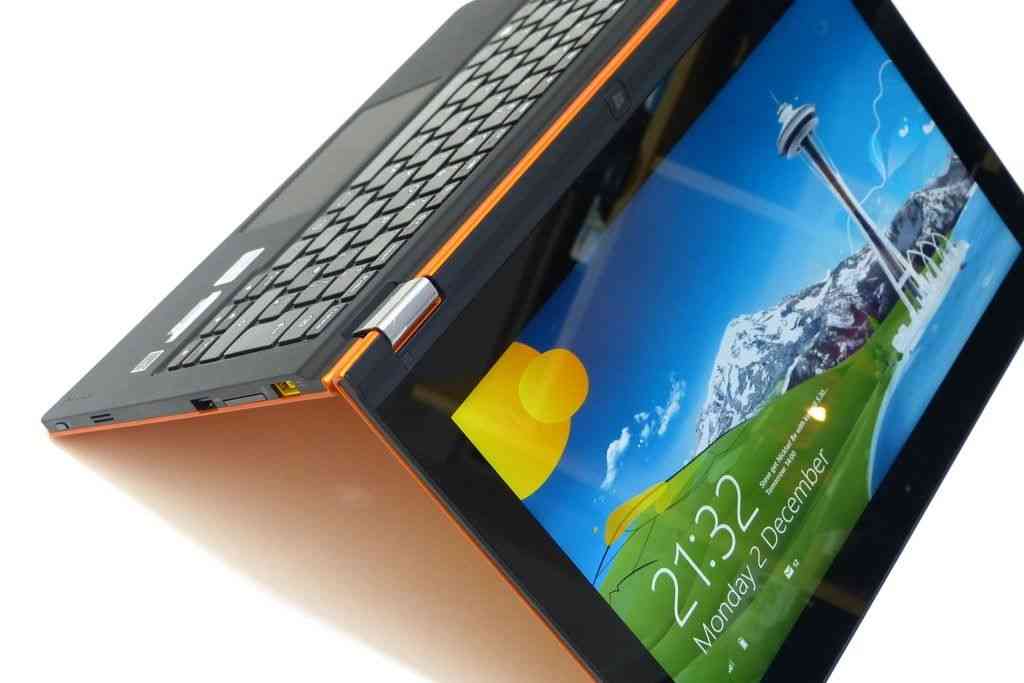
Lenovo Yoga 11S Review. 1.3KG Sub-notebook with Desktop Power
Posted on 04 December 2013
1.3KG with 11.6-inch screen. If that’s outside your target range for an ultra mobile PC, move on. If not, pay close attention because the Yoga 11S is an interesting touch-convertible with a Core i3 CPU that turns in some excellent all-round performance figures. Battery life and quality are up there too and to top it all off, you can get it for $699. From video editing to 2nd-screen sofa activity, it’s highly capable.
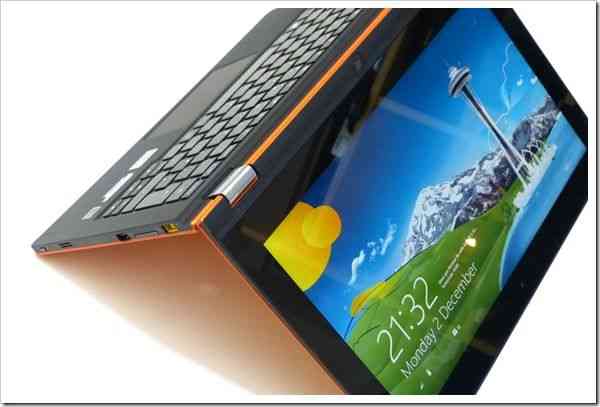
It’s easy to summarise the review that we’ve just published over at Ultrabooknews (in theory, this is an Ultrabook) by saying that the only thing you might not like about the Yoga 11S is that it doesn’t have the latest 4th-gen Core, Haswell, inside. WiFi performance could be better too but apart from that, there’s little to dislike.
One interesting discovery is that the CPU performance, the raw number crunching performance, is no better than the Baytail-T performance on the Transformer Book T100. However, when you factor in the better GPU performance, faster memory bus, 4GB RAM and very fast SATA-SSD, you end up with a far more capable PC. It’s worth bearing in mind when looking at Baytrail performance tests. PCMark on the Yoga 11S with Core i3-3229Y is better than that on the Tramsformer Pad T100 with Atom Z3740 and that doesn’t include the fast video enc/decoder and some other features of the Core i3.
At $699 it’s worth considering if you’re in the market for a sub-notebook. Oh, and the ‘Yoga’ fold-back screen feature is pretty good too.
Check out the full review of the Lenovo Yoga 11S (We’ve also got a review of the Core i7 version which is 50% more powerful in some cases) over at Ultrabooknews.
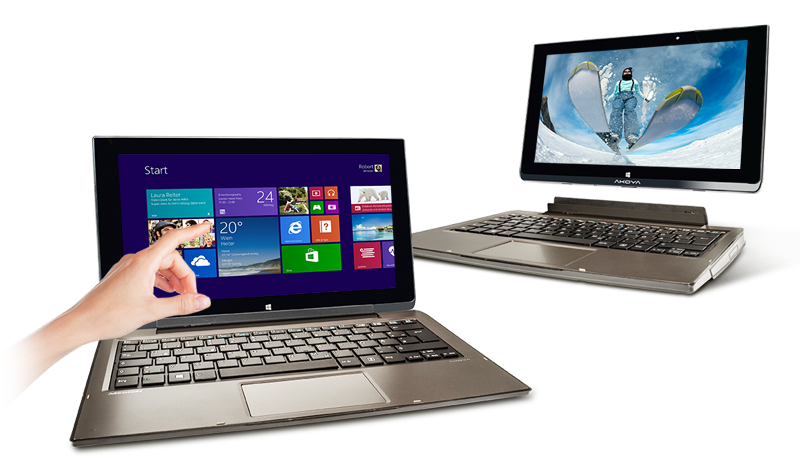
Medion Akoya P2212T. Impressive Specs, Price for this 11.6-inch 2-in-1
Posted on 02 December 2013
It’s clear that Baytrail-M PCs will be the low-cost options in the touch notebook and 2-in-1 space. This Medion Akoya P2212T, spotted in Austria, comes with a Celeron N2910, a Full-HD 11.6-inch screen, 64GB SSD + 500GB HDD and costs only 399 Euro, inclusive of taxes. There’s even an AC-capable WiFi module. Where’s the catch?
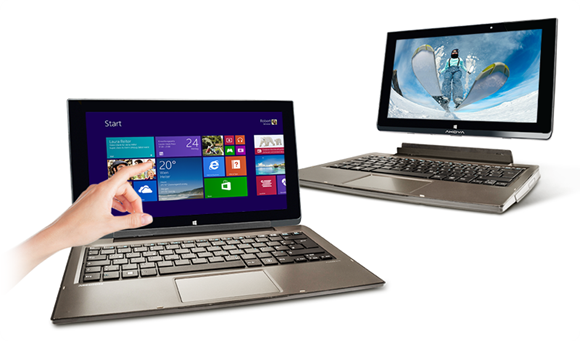

Ramos i10 Pro Could Run Dual-OS on Baytrail
Posted on 29 November 2013
If Intel and friends can pull-off the dual-OS trick in a slick way they’ll have a valuable selling point and a ‘bridge’ between the app-gap in Windows and the consumer richness of Android. Ramos already have a set of Intel-powered Android tablets in China but the Ramos i10 Pro is said to be coming with a dual-OS option on a Baytrail core.

Sony Vaio Fit T13A Flip Review
Posted on 24 November 2013
On first glance at IFA in September [article + video] I wasn’t overly impressed with the Sony Vaio Fit 13A Flip (let’s just call it the Sony Vaio Flip 13 shall we?) The wedge shape felt quite thick in tablet mode and the finish didn’t feel like quality. I’ve got a second chance to look at this 2-in-1 now though and it feels much, much better than the first time around. If you’re looking at the Samsung ATIV Book 9 Plus or even the ASUS Zenbook UX301, this is one convertible that should be on your ‘research this’ list.
Read the full story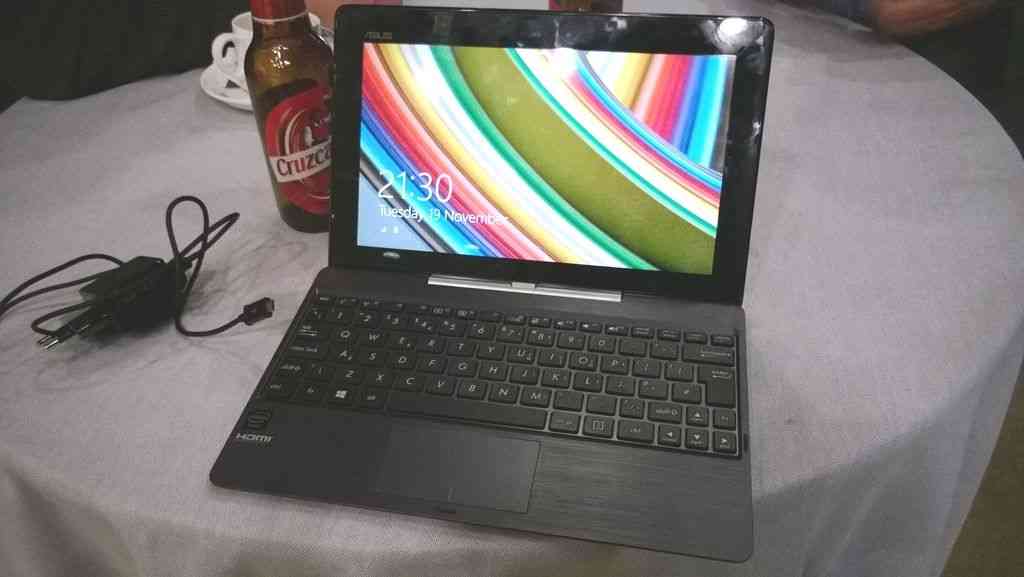
A Day with the ASUS Transfomer Book T100 + WiDi Demo
Posted on 22 November 2013
At the Intel Software Summit this week I had the chance to use the ASUS Transformer Book T100 for a day. I was very impressed at the performance level, quality and battery life but handed it back thinking it would work better as a productive device in an 11.6-inch version – as long as the tablet was the same weight.
You’ll find a lot of praise for the T100 out there both from professional reporters and owners. It’s the biggest selling laptop on Amazon.com (currently $379 for the 64GB version) and we’re seeing a lot of activity for it here on the site. It’s kicking off the 2-in-1 category nicely and will account for a lot of consumer Windows 8.1 sales. Developers take note. (My estimate is that it will sell 0.5 million units before the end of the year if ASUS can keep up with stock demand.)
To add to my previous hands-on then, I was impressed by the USB charging. A lightweight charger is a bonus although charging speeds are fairly slow. It will rarely need charging in the day though because after 8hrs of a ‘on’ at a conference (with about 4.5hrs screen-on) I had 40% battery free.
I also got the chance to test WiDi. It works!
I will say a word about the keyboard and touchpad. I felt that I was really back in that awkward netbook zone again as I used it. it was cramped and the touchpad was very basic. it’s a shame because this platform supports productive working. A boost to an 11-inch screen and a larger keyboard could be the answer for those wanting the best in dynamic-range. Obviously the Dell Venue Pro 11 is a hot contender here, and available very soon.
The ASUS T100 is the rare thing that is a bargain AND a ground-breaking product. ASUS’ price is so aggressive that it will, without a doubt, catalyse a big 2-in-1 device category just like it did with the netbook category. This time round though I feel it’s going to be a bigger, longer-lasting category. There’s no device size or specification restrictions this time round. Where netbooks peaked at about 50 million sales a year, I expect the 2-in-1 category to be much bigger and to last much longer. Developers, pay attention because there are already app opportunities related to the T100.
 |
| |||
 |
| |||
 |
| |||
 |
| |||
 |
| |||
 |
| |||
 |
| |||
 |
| |||
 |
| |||
 |
|

